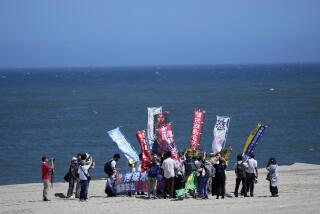Power company retracts report of extremely high radiation at Japanese nuclear plant
- Share via
Reporting from Tokyo — Officials at Japan’s stricken Fukushima Daiichi nuclear plant late Sunday retracted their announcement that they had found puddles at the facility’s No. 2 reactor containing 10 million times more radioactivity than would be found in water in a normally functioning nuclear reactor.
“The number is not credible,” Tokyo Electric Power Co. spokesman Takashi Kurita, said, according to the Associated Press. “We are very sorry.”
It was not immediately clear what led to the inaccurate reading of the water, or what the real level was. The company said on its website that there was a “mistake in the assessment of the measurement of iodine-134.”
Photos: Sifting through the remains of a home
The initial announcement of the extremely high levels of radioactivity in the turbine building of the No. 2 reactor was made by Japan’s Nuclear and Industrial Safety Agency, citing Tepco as the source of the data. The alarming-sounding disclosure raised questions about the source of the radioactivity and the extent of damage to the plant, as well as the threat to workers trying to stabilize the situation at Fukushima, which was crippled by the March 11 earthquake and tsunami that rocked Japan.
The subsequent retraction underscored the pressures Japanese officials and Tepco executives face in reporting information to the public. Government authorities and the company have been criticized for not providing information in a timely fashion to the public.
Engineers do not appear to be making much progress in restoring power to the stricken reactors, Dave Lochbaum of the Union of Concerned Scientists said Sunday. A picture of the control room for reactor No. 2 shows that workers have, indeed, restored lights in the control room, he said, but nothing else seems to be working.
All of the computer monitors are blank and none of the equipment status lights and gauges appear to be functioning. Even the clock is not working.
Tepco’s failure to release information about the plant may be occurring because the company doesn’t have the information, he said.
A Kyodo News survey released Sunday found that 58.2% of respondents did not approve of the government’s handling of the nuclear crisis at the crippled Fukushima Daiichi nuclear power plant, while 39.3% expressed approval.
But now, more than two weeks into the disaster, the updates — via news conferences, press releases, website data charts and Twitter feeds, all laden with technical terms such as “bequerels,” “microsieverts,” “millisieverts” and “iodine-131” — have become so frequent and so granular as to become essentially indecipherable and meaningless to the average person.
These days, a citizen in Tokyo concerned about radiation from the plant can check the Ministry of Education, Culture, Sports, Science and Technology’s website for daily atmospheric radiation readings by prefecture around the country, and in drinking water.
The Ministry of Land, Infrastructure, Transportation and Tourism offers reports on measurement of radiation doses around the Metropolitan Airports, and measurement of radiation doses around the Port of Tokyo, Yokohama, Kawasaki and Chiba.
The Ministry of Health, Labor and Welfare has notices regarding Japanese policy and regulations on the handling of food that might be contaminated by radioactive substances, as does the Food and Safety Commission.
Then there are daily briefings from Tepco itself, nuclear safety agency officials, chief Cabinet secretary Yukio Edano and, less frequently, Prime Minister Naoto Kan. Adding to the din of information are the Tokyo Metropolitan government, daily newspapers, radio, television and websites such as Yahoo Japan, not to mention the amateur nuclear experts who have set up webcams recording their own Geiger counters 24 hours a day around Japan.
Seiji Shiroya, an official with the Nuclear Safety Commission, which acts as a backstop to the Nuclear and Industrial Safety Agency, the nation’s regulatory watchdog, said he had doubts about the high radiation readings at the No. 2 reactor turbine building announced by Tepco. “If nuclear fission had occurred Tepco should have detected other radioactive elements but didn’t, which I don’t quite understand. I don’t think the measurement is accurate,” he told reporters.
Nuclear and Industrial Safety Agency spokesman Tatsuji Narita said the agency had received word from Tepco that the company thinks its initial reading might have been wrong and that it’s rechecking the radiation levels in the turbine building. “We are waiting for Tepco to get back to us with new results,” said Narita.
Photos: Sifting through the remains of a home
Makinen is a Times staff writer and Hall is a special correspondent. Times staff writer Thomas H. Maugh II contributed to this report.
More to Read
Sign up for Essential California
The most important California stories and recommendations in your inbox every morning.
You may occasionally receive promotional content from the Los Angeles Times.














